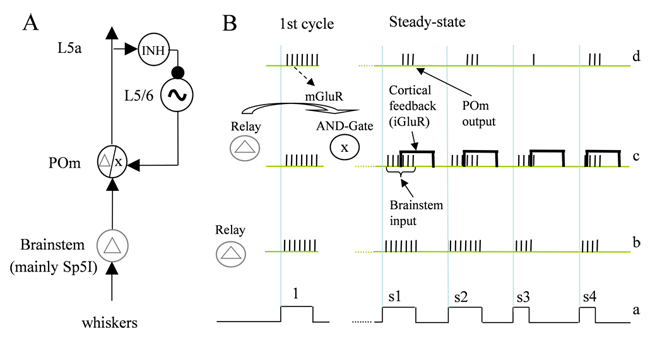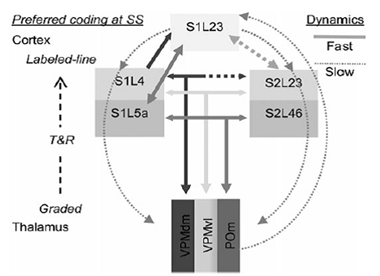Thalamocortical code conversion
Our studies revealed that thalamic “relay” nuclei are not mere relays. Rather, they process sensory information.

Thalamocortical coding

Neuronal representations of object location generated across these stations and expressed in response latency and magnitude were classified based on graded and binary coding schemes. Both graded and binary coding schemes occurred across the entire thalamocortical network, with a general tendency of graded-to-binary transformation from thalamus to cortex. Overall, 63% of the neurons of the thalamocortical network coded object position in their firing.
Thalamocortical responses exhibited a slow dynamics during which the amount of coded information increased across 4-5 cycles of artificial whisking and then stabilized. Taken together, the results indicate that the thalamocortical network contains dynamic mechanisms that can converge over time on multiple coding schemes of object location, schemes which essentially transform temporal coding to rate coding and gradual to labeled-line coding.
Relevant papers
-
(1997). Decoding temporally encoded sensory input by cortical oscillations and thalamic phase comparators. Proceedings Of The National Academy Of Sciences Of The United States Of America. 94:11633-11638.
-
(1998). Temporal-code to rate-code conversion by neuronal phase-locked loops. Neural Computation. 10:597-650.
-
(2000). Transformation from temporal to rate coding in a somatosensory thalamocortical pathway. Nature. 406:302-306.
-
(2001). Figuring space by time. Neuron. 32:185-201. (Review)
-
(2001). Size gradients of barreloids in the rat thalamus. Journal Of Comparative Neurology. 429:372-387.
-
(2006). Coding of stimulus frequency by latency in thalamic networks through the interplay of GABA(B)-mediated feedback and stimulus shape. Journal Of Neurophysiology. 95:1735-1750.
-
(2006). Parallel thalamic pathways for whisking and touch signals in the rat. Plos Biology. 4:819-825.
-
(2008). Latency coding in POm: Importance of parametric regimes. Journal Of Neurophysiology. 100:1152-1154.
-
(2015). Thalamic Relay or Cortico-Thalamic Processing? Old Question, New Answers. CEREBRAL CORTEX. 25:845-848.
-
(2015). Coding of Object Location in the Vibrissal Thalamocortical System. Cerebral Cortex. 25:563-577.


